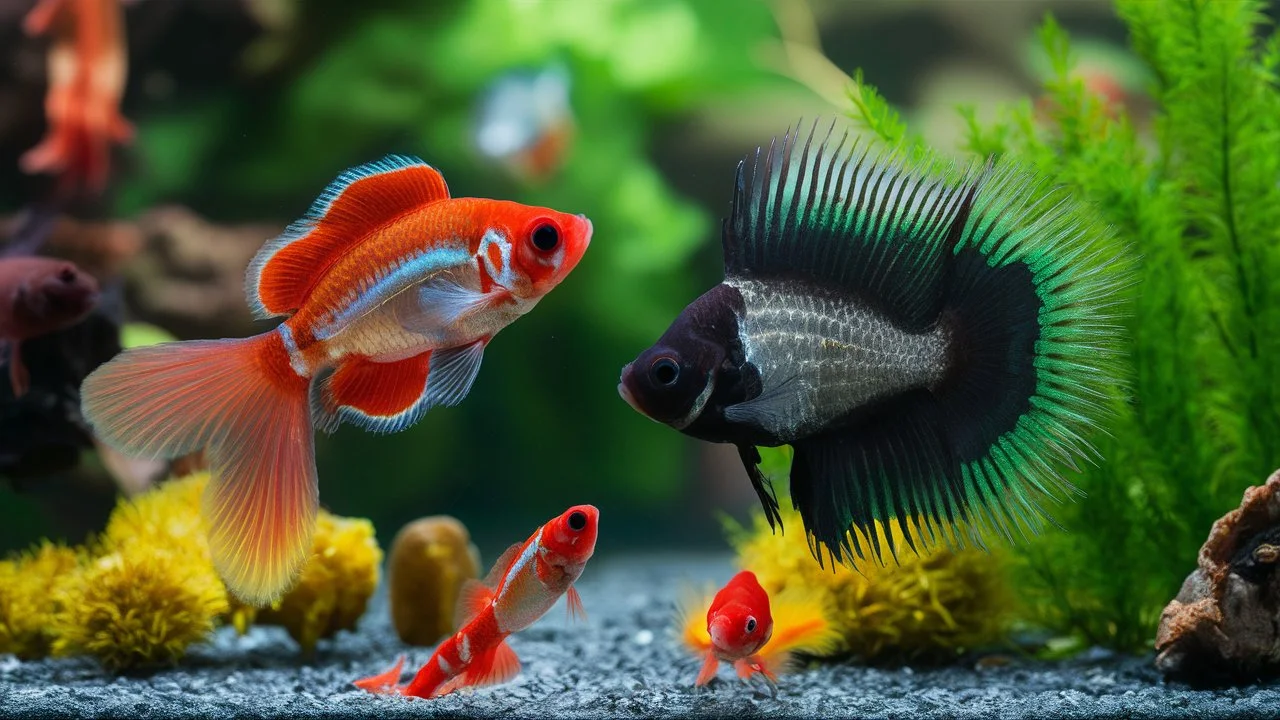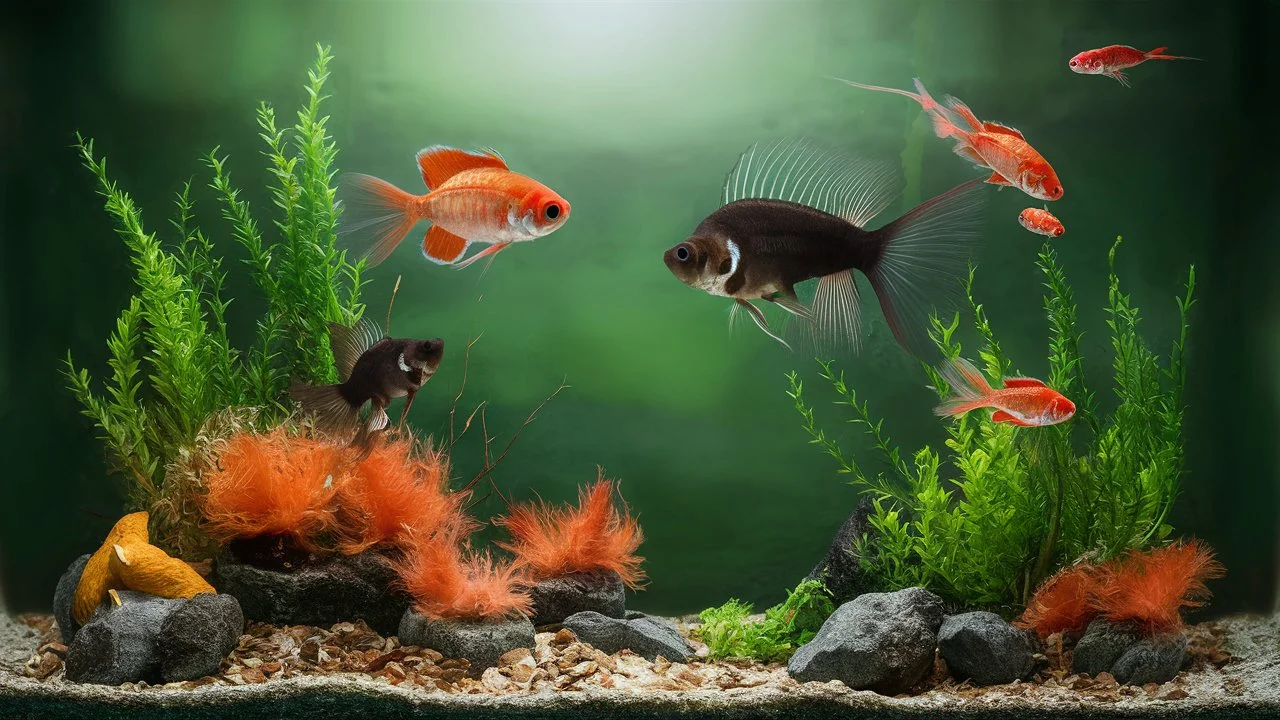As the title suggests, this article is about setting up the ideal community tank. Before we dive into the main topic, let’s address a common challenge for new aquarium owners. Many beginners struggle with deciding which fish to keep together. With hundreds of fish species and thousands of subspecies available, it can be overwhelming to choose the right combinations.
This confusion can lead to what’s known as choice paralysis, where people are unsure which fish to pair. A helpful tip is to select fish that complement each other and play different roles in the tank’s ecosystem.
Now, let’s focus on today’s topic – guppies and Siamese algae eaters. Can these two species live together, and what do you need to know about them?
Yes, Guppies and Siamese Algae Eaters can live together in the same tank. Both fish are generally peaceful and can coexist if their needs are met. Make sure the tank has enough space, proper water conditions, and plenty of hiding spots. Also, ensure they have a varied diet to keep them healthy. With the right care, these two fish can live happily together in your aquarium.
Can Guppies and Siamese Algae Eaters Live Together?
Guppies and Siamese Algae Eaters are two popular fish species among aquarium enthusiasts. They are both known for their unique features and ease of care. However, many fish keepers wonder if these two species can coexist peacefully in the same tank. In this article, we will explore whether Guppies and Siamese Algae Eaters can live together, considering their habitat requirements, behavior, diet, and more.
Related reading: Do Guppies Eat Mosquito Larvae?

Guppies: An Overview
Appearance and Behavior
Guppies are small, colorful fish that are easy to care for, making them a favorite among beginners. They come in various colors and patterns, and their active and playful behavior adds life to any aquarium. Guppies are generally peaceful fish that get along well with other small, non-aggressive species.
Habitat Requirements
Guppies thrive in warm water, with temperatures ranging from 72 to 82 degrees Fahrenheit (22-28 degrees Celsius). They prefer slightly alkaline water with a pH of 7.0 to 8.0. Guppies are not very demanding when it comes to their environment, but they do best in well-planted tanks with plenty of hiding spots and swimming space.
Diet
Guppies are omnivores, which means they eat both plant and animal matter. Their diet includes flakes, pellets, live or frozen foods like brine shrimp, and vegetables. A varied diet ensures that Guppies remain healthy and vibrant.
Siamese Algae Eaters: An Overview
Appearance and Behavior
Siamese Algae Eaters are slender, silver fish with a distinctive black stripe running from their head to the tail. They are known for their ability to control algae growth in aquariums. These fish are generally peaceful but can become territorial, especially as they grow older.
Habitat Requirements
Siamese Algae Eaters prefer slightly cooler water than Guppies, with temperatures ranging from 75 to 79 degrees Fahrenheit (24-26 degrees Celsius). They thrive in water with a pH between 6.5 and 7.5. These fish appreciate a tank with plenty of plants, rocks, and driftwood to provide hiding places and surfaces for algae to grow.
Diet
As their name suggests, Siamese Algae Eaters feed on algae, but they also require a varied diet. In addition to algae, they will eat vegetables, flakes, and pellets. Providing a balanced diet ensures they receive all the necessary nutrients.
Compatibility Factors
Water Conditions
One of the first things to consider when keeping Guppies and Siamese Algae Eaters together is their water requirements. While both species can adapt to a range of conditions, it is essential to find a middle ground that suits both. Maintaining a stable temperature around 75 to 78 degrees Fahrenheit (24-26 degrees Celsius) and a pH of 7.0 to 7.5 can create a comfortable environment for both fish.
Tank Size
Another important factor is the size of the tank. Both Guppies and Siamese Algae Eaters need ample space to swim and explore. A tank of at least 20 gallons is recommended when keeping these two species together. This size provides enough room for each fish to establish its territory and reduces the chances of aggression.
Behavior and Temperament
Guppies are known for their peaceful nature, while Siamese Algae Eaters can be somewhat territorial. However, if the tank is large enough and has plenty of hiding spots, these behaviors can be managed. Introducing the fish to the tank simultaneously and keeping a close watch on their interactions can help ensure they get along.
Dietary Needs
Feeding both species can be straightforward since their diets overlap. Guppies and Siamese Algae Eaters both enjoy vegetables, flakes, and pellets. Including algae wafers in the tank can help meet the dietary needs of Siamese Algae Eaters. Observing feeding times and ensuring that all fish are eating well is crucial for their health.
Setting Up the Tank
Aquascaping
Creating a well-planted tank with rocks, driftwood, and hiding spots is essential. Plants like Java moss, Anubias, and Java fern are good choices as they provide cover and surfaces for algae to grow. Driftwood and rocks offer hiding places for the Siamese Algae Eaters and help reduce territorial behavior.
Water Filtration and Maintenance
A good filtration system is vital to keep the water clean and maintain stable water parameters. Regular water changes, about 25% weekly, help keep the environment healthy. Monitoring water parameters regularly ensures that any fluctuations are quickly addressed.
Monitoring and Adjustments
Observing Behavior
Once the Guppies and Siamese Algae Eaters are in the tank, closely observe their behavior. Look for signs of stress or aggression, such as nipping or hiding. If any fish seem overly stressed or aggressive, consider rearranging the tank decor to break up territories or adding more hiding spots.
Health and Well-being
Regularly check the health of both species. Healthy fish are active, have bright colors, and eat well. If you notice any signs of illness, such as lethargy, loss of appetite, or unusual spots, take action immediately. Quarantine sick fish if necessary and consult a veterinarian or experienced fish keeper for advice.
Conclusion
In conclusion, Guppies and Siamese Algae Eaters can live together peacefully if their needs are met. By providing a suitable tank environment, maintaining proper water conditions, and ensuring a balanced diet, you can create a harmonious aquarium for both species. Always monitor their behavior and health to ensure they are thriving. With the right care, your Guppies and Siamese Algae Eaters can coexist happily, adding beauty and activity to your aquarium.

1 thought on “Can Guppies and Siamese Algae Eaters Live Together? Find Out!”